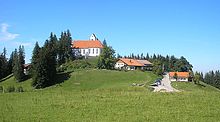St. Georg (Auerberg)
The Catholic branch church of St. Georg is located on the highest point of the Auerberg (1055 m, municipality of Bernbeuren ) in the Weilheim-Schongau district in Upper Bavaria . The simple sacred building contains some important pieces of equipment, such as a Mother of God by the Allgäu carver Jörg Lederer .
history
On the "big brother of the Hohenpeissenberg " there was a Roman military station under Emperor Tiberius. After the troops withdrew, the mountain was used as a civilian settlement for some time. However, the oldest traces of settlement date from the Neolithic Age . In Celtic times the Damasia fortress may have been on the hill. The extensive remains of the ramparts, which are still visible today, are assigned to the Roman civil and military settlement.
The Auerberg was an independent political municipality until 1836. The church was probably built in Roman times as a place of worship for the surrounding courtyards on the mountain. It is unclear whether it was ever a parish church . In 1497 the vaulted choir was added. The nave was not built until after the Thirty Years War . In 1955 and 1997 the building was restored. The renovation, which began in 2017, was completed with the consecration at the Georgiritt on April 28, 2019.
The Auerbergkirche is still a pilgrimage church and the destination of a Georgi ride , in which 14 old peasant families used to take part.
description
The oldest part of the church is the Romanesque saddle roof tower in the northern corner of the choir, via which you can now access the viewing platform on the church roof. From here you can supposedly see 230 towns. The choir itself dates from 1497 and closes in five sides of the octagon. The single nave nave is wider than the presbytery and, like the choir, has no buttresses .
The nave has a flat roof. The simple wooden paneled ceiling was probably created shortly after the Thirty Years War. The three-bay chancel is slightly lower than the lay room and is spanned by a late Gothic net rib vault. The keystones show St. George, a miter and the coat of arms of the Augsburg bishop Johann von Werdenberg . The walls of the church are broken through by simple arched windows, in the south a sign (porch) allows entry.
St. Georg used to be surrounded by the Auerberg cemetery. The walling - which is essentially late medieval - is still preserved.
Furnishing
The simple west gallery rests on a wooden central column and is decorated with some votive pictures.
The side altars, like the pulpit, date from the middle of the 17th century (Jörg Pfeiffer). The high altar was built despite its rococo forms until 1781. The altar painting is the work of Franz Anton White (Rettenberg, mar. 1767), and the transfer is the miraculous image of Genazzano.
The choir contains the most important works of art in the church. The Mother of God by Jörg Lederer is placed above the entrance to the sacristy. The Madonna (around 1520) stands on the crescent moon and depicts the baby Jesus. The large rosary Madonna from 1641 hangs in the choir arch. The gothic work was probably made in a workshop in Weilheim . To the south of the high altar, the outer wings of a late Gothic winged altar with depictions of the Fourteen Holy Helpers and the Annunciation have been preserved (around 1520).
The figure of St. To mention Georg with the kite next to the gallery. The popular image was created in 1675.
literature
- Georg Paula , Stefanie Berg-Hobohm : District Weilheim-Schongau (= Bavarian State Office for Monument Preservation [Hrsg.]: Monuments in Bavaria . Volume I.23 ). Lipp, Munich 2003, ISBN 3-87490-585-3 .
- Hugo Schnell: Bernbeuren, OBB. in the Pfaffenwinkel. (Schnell & Steiner Art Guide, No. 216). Regensburg, 1937 (used 15th edition 1999. ISBN 3-7954-4187-0 )
Web links
Coordinates: 47 ° 44 ′ 11 " N , 10 ° 44 ′ 14" E




